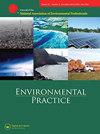回填壕中的非抽水井与含有和处理受污染地下水的渗透性反应屏障
Q3 Social Sciences
引用次数: 2
摘要
流量和质量输运模型模拟了两种低能耗地下水修复策略:1)渗透性反应屏障和2)在回填沟渠中带过滤筒的非抽水井。这两个结构都占据了污染羽流尖端向下梯度5米的线性样带,并垂直于当地的水力梯度。在四种模拟的均质和非均质环境中,模型确定了最短的可渗透反应屏障(纵向测量,与环境水力梯度垂直)或容纳和去除污染羽流所需的最少数量的非泵送井的位置。研究结果表明,在某些情况下,将非抽水井安置在回填含水层材料的沟槽中(如果从监管角度允许的话)可能是一种可行的替代方案,可以替代成本更高的渗透性反应性屏障。本文章由计算机程序翻译,如有差异,请以英文原文为准。
Non-Pumped Wells in Backfilled Trenches versus Permeable Reactive Barriers for Containing and Treating Contaminated Groundwater
A flow and mass transport model simulated two low-energy groundwater remediation strategies: 1) a permeable reactive barrier and 2) non-pumped wells with filter cartridges in a backfilled trench. Both structures occupied a linear transect 5 m downgradient of the leading tip of a contaminant plume and perpendicular to the local hydraulic gradient. In each of four simulated homogeneous and heterogeneous settings, models identified the shortest permeable reactive barrier (measured lengthwise, normal to the ambient hydraulic gradient) or locations of the smallest number of non-pumped wells necessary to contain and remove a contaminant plume. Results suggest that non-pumped wells emplaced in trenches backfilled with aquifer material (when allowed from a regulatory perspective) may be a viable alternative to more costly permeable reactive barriers in some settings.
求助全文
通过发布文献求助,成功后即可免费获取论文全文。
去求助
来源期刊

Environmental Practice
ENVIRONMENTAL SCIENCES-
CiteScore
0.90
自引率
0.00%
发文量
0
期刊介绍:
Environmental Practice provides a multidisciplinary forum for authoritative discussion and analysis of issues of wide interest to the international community of environmental professionals, with the intent of developing innovative solutions to environmental problems for public policy implementation, professional practice, or both. Peer-reviewed original research papers, environmental reviews, and commentaries, along with news articles, book reviews, and points of view, link findings in science and technology with issues of public policy, health, environmental quality, law, political economy, management, and the appropriate standards for expertise. Published for the National Association of Environmental Professionals
 求助内容:
求助内容: 应助结果提醒方式:
应助结果提醒方式:


